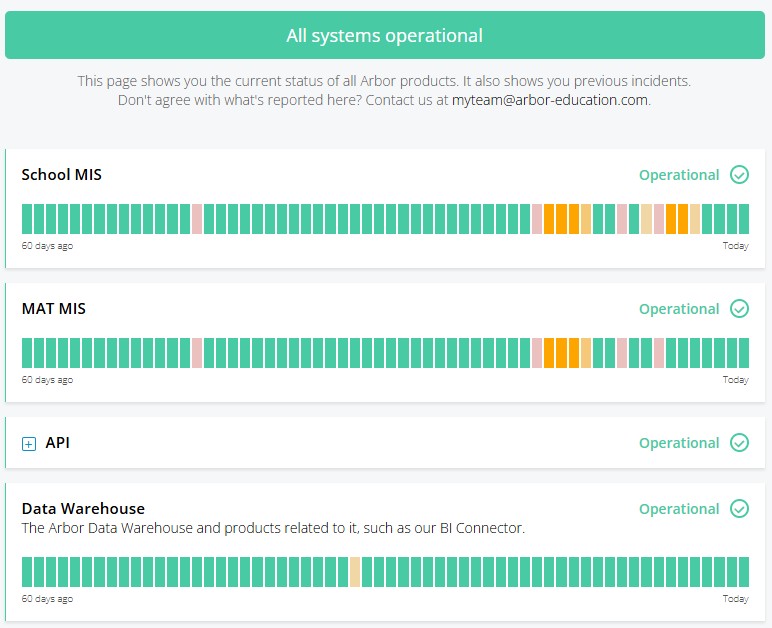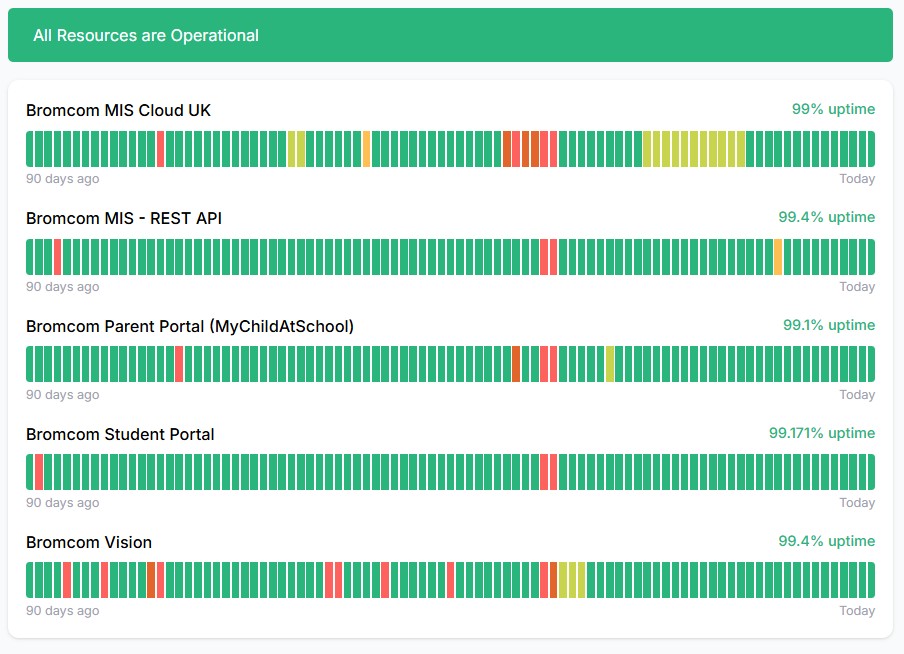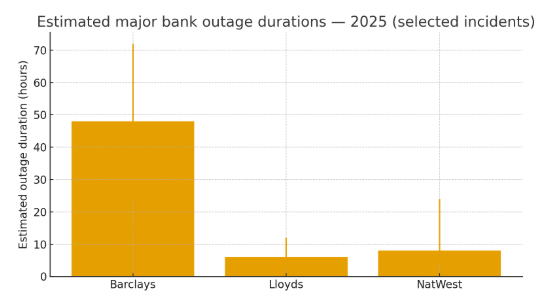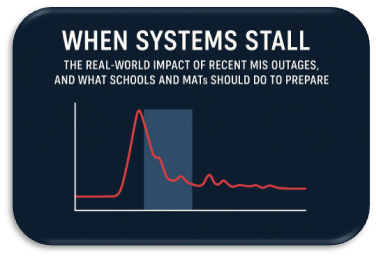The real-world impact of recent MIS outages, and what schools and MATs should do to prepare
Following on from our post last month about MIS outages, we thought we’d run a follow up article.
Over the last few weeks major UK school software suppliers Bromcom and Arbor have both reported interruptions to their cloud MIS platforms.
Although these systems are generally reliable and outages are rare compared with normal day-to-day uptime, when they do happen the operational impact on schools can be immediate and severe:
from the inability to take attendance, run clubs or missed safeguarding alerts and inaccessible timetables to payroll/finance delays, take payments, and frustrated parents and staff.
In this post we try to explain:
(a) why a rare outage matters so much in education,
(b) how these incidents compare with outages at other big services,
(c) a practical, prioritised checklist for what schools and multi-academy trusts (MATs) should do now, before the next outage.
Why a “rare” outage causes considerable pain in schools
Most modern MIS platforms are cloud-hosted and built to very high availability standards.
Providers routinely publish status and uptime information and, for most of the year, schools can rely on them without incident.
Both vendor status pages report normal operating periods between incidents – see below:


But when an outage does occur, the effect is amplified because schools use MIS for many critical daily tasks: attendance and registers, safeguarding records, parent communications, dinner-money/meal payments, payroll and finance workflows, rooming and timetables, and exam or assessment administration. When those systems aren’t available, multiple business processes stop at once.
Problems can be widely felt with leaders reporting being unable to access timetables, run after-school clubs, process some payments or deal quickly with safeguarding tasks — producing real operational risk and significant extra work for school staff.
Arbor published guidance for business continuity:
Arbor Business Continuity Recommendations – Arbor Help Centre
These outages are uncommon — but comparable to failures at other large cloud services
Outages of big cloud platforms are not the day-to-day norm, but they are not unheard of either. Major tech and financial organisations have suffered highly visible outages in the past decade — M&S, The Co-Op, Harrods Microsoft 365 as well and Lloyds & Nat West have all had incidents that temporarily disrupted huge numbers of users. These incidents reinforce an essential point: no cloud provider or large IT service is immune to outages
UK Banks – Major IT Outages in 2025
Barclays
Dates: Jan 31 – Feb 2
Impact: 56% of online payments failed due to mainframe degradation.
HSBC
Date: March
Cause: Fault in a technical component.
Lloyds Bank
Date: February 28 (Payday)
Impact: 700,000 customers affected; latency issues.
Issues: Hardware failures, capacity constraints, third-party changes, database
Nationwide
Date: August
Impact: Mobile and online banking services went down
First Direct
Date: September 30
Impact: Full outage during payday; customers locked out.
Metro Bank
Date: October 7
Impact: Payment services failed; inaccurate balances reported

UK Retailers – Major IT Outages in 2025
Marks & Spencer (M&S)
Date: April–May
Cause: Ransomware attack (DragonForce via Scattered Spider).
Impact: Website/app offline for 46 days; £700M market value loss; £300M profit
Co-op
Date: May
Impact: 2,300 stores affected; tills and supply chain disrupted.
Harrods
Date: May
Impact: Attempted breach; internet access restricted across stores.
H&M
Date: June
Impact: In-store payment systems briefly offline.
There were also disruptions to the Microsoft 365 services in October 2025 that affected many users.
You may also recall “global outage” causing a total Windows-level or massive systems outage (not just 365/Teams), in July 2024, when a CrowdStrike-related global outage occurred, which caused widespread Windows crashes.
The comparison matters because it frames expectations. Outages are (fortunately) rare, but because modern organisations outsource core infrastructure, the blast radius when things go wrong can be wide and unpredictable.
What schools and MATs should do now — a practical, prioritised plan
What schools and MATs should do now — a practical, prioritised plan
Below is an operational checklist you can use immediately. It is ordered roughly from highest to lower immediate risk and with small actions you can do quickly as well as medium-term work.

Immediate:
- Document critical processes that depend on the MIS.
- Identify the top 8–12 functions that would stop if MIS is down (registers & attendance, safeguarding logs, parent contact details, payroll, dinner payments, billing, timetables, exam entries). Put them in a single short spreadsheet or page.
- Ensure local access to contact lists.
- Export and securely store (off-network) a current pupil/staff emergency contact spreadsheet and DSL (Designated Safeguarding Lead) contact list — updated weekly and held in a secure place accessible to SLT by phone.
- Create and circulate an outage handbook.
- A ‘one pager’ for staff including, who to call, who declares an incident, how to log incidents manually (paper registers, a shared spreadsheet held off the vendor cloud), and agreed temporary flows for safeguarding referrals and parental messaging.
- Set up alternative communication channels.
- Confirm phone distribution lists, SMS/parent app alternatives and an agreed WhatsApp/ Twitter/website post template so parents get clear, calm updates quickly.
- Check payroll/finance protections.
- Confirm whether payroll runs will complete without MIS (many payroll suppliers can run from locally stored files). Where necessary agree a manual contingency with your payroll/finance supplier so staff still get paid on time.
Guidance from the Department for Education, as well as DfE procurement advice, stresses that schools should understand supplier availability and have contingency plans.
Short term: (this week to month)
- Export and automate backups of key reports.
- Schedule automated daily exports of current register, pupil details, medical/allergy notes, DSL notes, timetables and the finance/bank file used to pay suppliers.
- Agree SLAs and escalation contacts with your supplier.
- Make sure you have named supplier contacts, escalate paths and a communications subscription to the vendor status page for real-time alerts. Confirm how the supplier will notify you (email, phone, status page).
Bromcom – status.bromcomcloud.com,
Arbor – https://status.arbor-education.com/,
ESS SIMs – https://customer.support ess.com/csm?id=kb_article_view&sysparm_article=KB0037319
- Run a short table-top exercise.
- Walk through the outage runbook with SLT and office staff.
- Simulate a morning when registers and parent messages are unavailable. This highlights gaps and reduces panic in a real event.
Medium term (1–3 months)
- Formalise contractual protections.
- On contract renewal or procurement, insist on clear availability SLAs, response times, post-incident reports and remedies. Keep records of previous incidents (status pages, vendor community posts) to inform negotiations. (DfE commercial guidance recommends assessing agreed levels of service and planning accordingly.) (GOV.UK)
- Build redundancy for the highest-risk functions.
- For example, use a small local finance system or MAT shared finance workflow that can accept manual input for supplier payments, or a simple ParentMail/SMS fallback for urgent communications.
- Align insurance and risk registers.
- Ensure continuity and cyber insurance cover your operational loss scenarios, and record MIS outages in your risk register with mitigations and owners.
Longer term (3–12 months)
- Demand post-incident transparency from suppliers.
- If your MIS experiences an outage, ask for a post-incident report that includes root cause, exact timeline, impact scope and remediation actions. Major cloud providers publish post-event summaries for transparency — demand the same standard from education suppliers. (Amazon Web Services, Inc.)
- Review multi-vendor resilience.
- For MATs, consider whether splitting critical functions across providers (or keeping an on-prem backup for selected datasets) reduces single points of failure.
- Train staff and governors.
- Make contingency plans part of governor oversight and staff induction — confidence and clarity reduce both risk and reputation damage during incidents.
What to expect from suppliers (and what to ask for)
Real-time status updates and clearly published incident timelines on a status page.
- Arbor – https://status.arbor-education.com/
- Bromcom – status.bromcomcloud.com,
- ESS SIMs – https://customer.support ess.com/csm?id=kb_article_view&sysparm_article=KB0037319
Named escalation contacts and an agreed response cadence for major incidents. - Post-incident transparency (root cause analysis, impact scope, remediation plan). Big cloud providers publish these; ask your MIS supplier to follow the same pattern.
Final thoughts — rare doesn’t mean negligible
Cloud MIS platforms remain the right choice for most schools: they centralise data, reduce local IT burden, and are highly reliable for the vast majority of the year.
But the landscape of IT outages — from Bromcom and Arbor’s recent incidents to historic outages at Google, AWS, Microsoft and major banks — shows the same lesson again and again: outsourcing reduces day-to-day friction but concentrates risk. Planning, simple exports, clear processes and tested contingency procedures convert a rare outage from a “car crash” into a manageable disruption.

